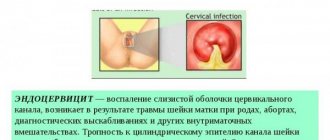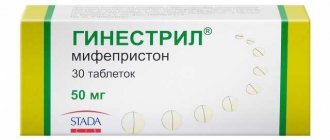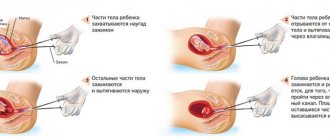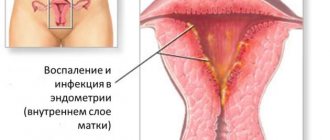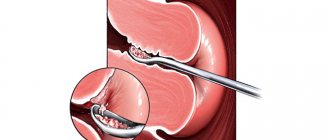temperature after cleaning a frozen pregnancy
Questions and answers on: temperature after cleansing a frozen pregnancy
Thank you very much for the answer.
Tell me, please, what is the connection between homocysteine and VEGF levels? I couldn't find it on the Internet. And, to my great regret, I did not find a laboratory that provides this analysis. At least, I didn’t see one in the list on Internet pages. But I will still find out by phone. I want to clarify about homocysteine. I had 11.78 µmol when the laboratory norm was 12 µmol. But my gynecologist said that these are old norms and that it should be no more than 9. I took folic acid and monthly B vitamins. A month later, my homocysteine was already 6-something, I don’t remember exactly. After another month, 3-something -That. And please tell me, what causes hyperhydroamnion? Could this factor cause the death of the fetus? Sorry for so many questions. I really want a child and am terribly afraid of repeating a frozen pregnancy.
Just in case, I'll copy my previous question and your answer. Answer to your question March 21, 2013 Natalya asks: Hello. Please help me figure it out. I'm 34, my husband is 42. My daughter is 10 years old. We decided to have a second child. I was tested for Torch infection - negative. A vaginal smear showed Gardrenella. Treated. Cervical erosion was discovered. I did cryodestruction. Ultrasound of the pelvic organs, abdominal cavity, and thyroid gland is normal. I have fibrous mastopathy, which I periodically check with ultrasound. Hormone tests: prolactin, progesterone, thyroid-stimulating hormone, antibodies to peroxidase - normal. Human papillomavirus was not detected. Homocysteine was slightly elevated. She brought it back to normal and became pregnant. During pregnancy, homocysteine was good. At the 5th obstetric week of pregnancy, I started to smear quite a bit and not every day (once every 3 days) with brown discharge. I did an ultrasound. Everything is fine. The uterus is normal tone. Duphaston was prescribed - 2 tablets per day. At the planning stage and during pregnancy, I took folic acid - 4 mg and various multivitamin complexes intermittently. At the sixth obstetric week, I had a severe runny nose, my throat hurt a little, but there was no fever. She was treated with inhalations of chamomile and soda, honey and took a couple of Engystol tablets (homeopathy). She was cured in 5 days. During this period, severe toxicosis began. After taking duphaston for a week, the discharge stopped completely. At 12 obstetric weeks, an ultrasound scan said that the fetus had frozen at 8 weeks and that there were signs of hyperhydroamnion. They cleaned it and said it was a vacuum. Although at this time is it really possible? Please tell me what tests I need to take before my next pregnancy? Should my husband take a spermogram, given that 2 pregnancies were completed without problems, as soon as we wanted. Could a cold in such a fairly mild form lead to the death of the fetus? Is it possible to plan a pregnancy after 4 months? What is the likelihood that this horror could happen again? Thank you!
March 25, 2013 Igor Evgenievich Palyga answers: Reproductologist, Ph.D. information about the consultant It makes no sense for your husband to take a spermogram, you get pregnant without any problems. A cold could theoretically affect the course of pregnancy, but it would lead to fading, this is doubtful. I recommend for 20-24 days m.c. get tested for VEGF, given that homocysteine was elevated. With an increased level of VEGF, it is necessary to administer low molecular weight heparins under the control of a coagulogram + vit. gr.B+ folic acid for 2 months. before planning pregnancy and in the first months. pregnancy. Get pregnant in 4 months. theoretically you can, but first you need to be examined.
Questions
Question: Temperature after curettage?
The site provides reference information for informational purposes only. Diagnosis and treatment of diseases must be carried out under the supervision of a specialist. All drugs have contraindications. Consultation with a specialist is required!
Hello. I had a frozen pregnancy at 8 weeks. Ultrasound showing. only the fertilized egg for 5-6 weeks. The embryo is not visualized. After curettage, the doctor prescribed Ofloxacin 0.4 * 3 w.d. 5 days. I read the instructions - the maximum daily dose is 800 mg. I get 1200 mg (there was swelling and nausea, I independently reduced the dose to 800 mg). Will this affect the therapeutic effect? Vaginal tablets Ginalgin were also prescribed. Fluconase (150 mg) once Is it worth taking something else (for example Nystatin) to prevent candidiasis? Before the curettage and in the hospital, the body temperature was 37.2. Now I have been taking Ofloxacin for 5 days, Ginalgin (suppositories), Diclofenac (suppositories) the temperature is there all the days (during the day it changes from 36.9 to 37.3). Is this normal? What could be the reason? The local gynecologist told me to come for an examination 2 weeks after curettage. Only a week has passed. Is it worth running to the hospital if there is no pain or discharge? The only concern is the temperature
In this situation, you need to continue the treatment prescribed by the gynecologist. You can come for the examination at the appointed time. An increase in temperature to 37.5 is quite acceptable after curettage; to exclude the presence of an inflammatory process, you can take a general blood test. As for antibacterial therapy, exceeding the dosage specified in the instructions is permissible only in exceptional cases.
Tell me, the treatment is prescribed for only 5 days. They have already passed. Is this not enough? Maybe you need to continue using Ginalgin? And when can you resume sexual activity, if with a condom? There is no discharge.
It is advisable to re-consult with your doctor, at least by telephone, and clarify the treatment regimen. Until a re-examination by a gynecologist, it is necessary to abstain from sexual activity, even with the use of a condom.
Good afternoon Three days ago, a cleansing was performed after a miscarriage at 5 weeks. An hour after the procedure, I replaced the rag lining with a hygienic one. There was a small amount of blood on the rag. And nothing on the hygiene line. Three days have already passed, and there is no discharge at all. Oxytocin was started on the same day, and gentamicin a day later. The next day after the operation, the temperature rose to 37.5C and did not fall. I feel simply terrible: severe dizziness, headache, hot flashes. This may be related to the temperature, of course, but I am concerned about the lack of discharge. Please tell me, if I now do an ultrasound and a clinical blood test, will it be informative? Will it be known whether there are complications or not? And if discharge does not appear, what actions should be taken on my part and how long will the temperature and such a terrible condition last? Thank you!
Metroendometritis
Metroendometritis is a combined inflammation of the mucous and muscular layers of the uterus. After cleaning, pathology is formed relatively rarely. The cause of metroendometritis is the penetration of opportunistic microflora into the uterine cavity from the vagina or fallopian tubes, as well as pathogenic microorganisms and the patient’s failure to comply with the antibiotic regimen.
With metroendometritis, both the endometrium and myometrium are involved in the pathological process.
After infection penetrates into the uterine cavity, the endometrium is involved in the pathological process and only later, as a result of the penetration of infectious agents into the deeper layers, does the muscle layer (myometrium) become inflamed. In most cases, metroendometritis is formed precisely after curettage (cleaning), since it is during the procedure that severe damage to the endometrium occurs.
Symptoms
Metroendometritis occurs differently in all women, but certain symptoms still exist. It is worth including these.
- Pain in the projection of the uterus. In acute endometritis, pain is eliminated with the help of painkillers, but after the myometrium is involved in the pathological process, the pain becomes unbearable. They radiate to the lumbar region, groin or rectum.
- Serous-purulent discharge, which is determined during a gynecological examination.
- Vaginal discharge that looks like meat slop.
- Soreness of the uterus on palpation. An attempt to palpate the uterus is accompanied by severe pain.
Symptoms of acute metroendometritis can develop three to four days after completion of uterine cleansing.
In order to prevent inflammation, after cleaning the uterus, a woman must take medications from the category of antibiotics. An increase in temperature after curettage is an unfavorable symptom that requires qualified medical advice.
Inflammation of the uterus can lead to the spread of microorganisms to the ovaries and tubes, which can lead to the development of adhesions and infertility. Serious complications such as peritonitis and sepsis pose a danger to a woman’s life, therefore, if the temperature rises after curettage, it is necessary to urgently seek medical help.
temperature after cleaning
User comments
Sorry for writing late. I just had a cleanse on February 1 and the temperature stays at 37-37.2 constantly... I also don’t know what to think. How did it all go for you then?
Then they started putting me on IVs... and it more or less returned to normal.
During the second cleaning, the temperature was also slightly elevated, but nothing bothered me. Did you have an ultrasound? are you in the hospital yet?
I was discharged on the third day... I didn’t do an ultrasound... I take antibiotics and anti-inflammatory tablets. I'm only going to donate blood and urine on Monday... I'm worried about the temperature.
I remember that at some point my level rose to 37.5, I threw a quarrel in the hospital, and in the end they put me on IVs. that is, they gave me injections for almost a week, and then they started giving me IVs. The cleaning was on Wednesday, the hospitalization was on Monday. and the IVs were installed on Sunday. something like this.
but in principle, in connection with surgery, this is normal.
If I were you, I would go for an ultrasound if possible...
Temperature after cleaning the uterus
The temperature after diagnostic or therapeutic curettage of the uterus rises for only one reason - the development of inflammation. The provoking factor may be the introduction of infection into the organ cavity during cleaning during medical procedures, the penetration of pathological microflora from the vagina, as well as the activation of the infectious process that took place before curettage of the uterus.
Normally, the next day after the procedure, the body temperature returns to normal. A temperature that rises to high or low-grade levels after curettage may indicate the development of the following infections:
- cervicitis – inflammation of the vaginal segment of the cervix;
- endometritis – inflammation of the inner surface of the uterus;
- pyometra – suppuration of the liquid contents of the uterus;
- metroendometritis – combined inflammation of the endometrium and myometrium;
- peritonitis - initiation of inflammation of the abdominal cavity, as a complication of inflammation of the uterus;
- sepsis is the penetration of uterine infection pathogens into the blood.
Cervicitis
The reason for the increase in temperature - sometimes to very significant levels - after cleaning (curettage) of the uterine cavity is inflammation of the vaginal segment of the cervical canal.
In addition to high fever, the disease is characterized by the appearance of vaginal discharge. They can be either mucous or contain purulent impurities. In addition, the pathology is accompanied by pain in the lower abdomen, as well as significant discomfort accompanying the process of urination.
There are two forms of cervicitis. The gradation depends on which tissues of the cervical canal were involved in the pathological process.
- When the vaginal part of the cervical canal becomes inflamed after curettage of the uterus, a woman develops exocervicitis.
- If, after cleaning, inflammation of the inner surface of the cervical canal of the uterus begins, then we are talking about endocervicitis.
The main cause of the disease is tissue damage during uterine curettage, which is subsequently joined by nonspecific infectious agents. The development of inflammation after cleansing and the accompanying rise in body temperature can be provoked by:
- staphylococci;
- coli;
- streptococci, etc.
After cleaning (scraping) the uterine cavity, the female body becomes more vulnerable to various types of infections as a result of decreased immune defense.
In addition to its own opportunistic flora, inflammation and fever are caused by pathogenic microorganisms. Pathogens such as chlamydia, mycoplasma and ureaplasma, viruses can provoke cervicitis when open sexual activity begins after cleansing earlier than recommended by the doctor. The disease also becomes more active if the infection has progressed before the cleansing. Failure to comply with the principles of rational antibiotic therapy leads to cervicitis and a rise in temperature after cleaning.
Pyometra
Pyometra, which is also accompanied by an increase in temperature, is a purulent endometritis. The development of pathology is preceded by the formation of hematometra. In addition to high temperature, the condition is characterized by the accumulation of purulent liquid contents in the uterine cavity. Most often, pyometra develops against the background of complications after curettage (cleaning).
The main reason for the formation of pyometra is the closure of the cervix, which prevents the natural outflow of blood and the subsequent addition of a secondary bacterial infection. As a result, the accumulated liquid contents transform into pus.
Obstruction of the cervical canal can be caused by various reasons. In particular, the free flow of blood from the uterine cavity can be prevented by:
- polypous formations in the lumen of the cervical canal;
- fragments of the fertilized egg, if the cleaning was carried out for the purpose of abortion, etc.
The development of pyometra can be facilitated by cervical stenosis, which can also occur against the background of curettage of the organ.
Symptoms
The disease has an acute onset and is accompanied by characteristic clinical signs:
- the presence of severe cramping pain in the lower abdomen;
- voluminous purulent discharge, accompanied by an unpleasant putrefactive odor;
- high body temperature, chills and deterioration in general condition - symptoms indicate purulent intoxication of the body.
When palpating the lower abdomen, the gynecologist determines an enlarged, painful uterus. One of the signs of pyometra, in addition to an increase in body temperature, is a sudden cessation of discharge after curettage (cleaning) of the uterus.
In diagnosing pyometra that has developed after cleaning, in addition to the presence of high temperature, an important role is played by a gynecological examination.
